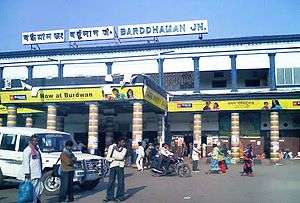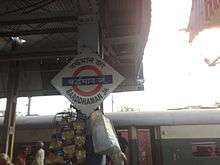Barddhaman Junction railway station
Barddhaman | ||||||||||||||||
|---|---|---|---|---|---|---|---|---|---|---|---|---|---|---|---|---|
| Indian Railway Junction Station | ||||||||||||||||
 | ||||||||||||||||
| Location |
Grand Trunk Road, Bardhaman, West Bengal India | |||||||||||||||
| Coordinates | 23°14′57″N 87°52′14″E / 23.2491°N 87.8705°ECoordinates: 23°14′57″N 87°52′14″E / 23.2491°N 87.8705°E | |||||||||||||||
| Elevation | 34.00 metres (111.55 ft) | |||||||||||||||
| Owned by | Indian Railways | |||||||||||||||
| Operated by | Eastern Railway | |||||||||||||||
| Line(s) |
Howrah-Delhi main line Howrah-Gaya-Delhi line Howrah-Allahabad-Mumbai line Howrah-New Jalpaiguri line Howrah-Bardhaman main line Howrah-Bardhaman chord Bardhaman-Asansol section Burdwan Katwa Railway | |||||||||||||||
| Platforms | 8 | |||||||||||||||
| Construction | ||||||||||||||||
| Structure type | Standard (on ground station) | |||||||||||||||
| Parking | Yes | |||||||||||||||
| Bicycle facilities | Yes | |||||||||||||||
| Other information | ||||||||||||||||
| Status | Functioning | |||||||||||||||
| Station code | BWN | |||||||||||||||
| Division(s) | Howrah | |||||||||||||||
| History | ||||||||||||||||
| Opened | 1855 | |||||||||||||||
| Electrified | 1958 | |||||||||||||||
| Previous names | East Indian Railway Company | |||||||||||||||
| Services | ||||||||||||||||
| ||||||||||||||||
| Location | ||||||||||||||||
 Bardhaman railway station Location in West Bengal | ||||||||||||||||
Barddhaman is a railway junction station on the Howrah-Delhi main line and is located in Bardhaman district in the Indian state of West Bengal. EMU services from Howrah along Howrah-Bardhaman main line and Howrah-Bardhaman chord terminate at Bardhaman. It serves Bardhaman, the fifth most populous city in West Bengal.[1]
History
The first passenger train in eastern India ran from Howrah to Hooghly on 15 August 1854. The track was extended to Raniganj by 1855.[2]
The Howrah–Bardhaman chord, a shorter link to Bardhaman from Howrah than the Howrah–Bardhaman main line, was constructed in 1917.[3]

Barddhaman RRI
It has seimens interlocking and it was commissioned on 2014. New RRI has considerably increased train punctuality.
Electrification
Electrification of Howrah—Burdwan main line was completed with 25 kV AC overhead system in 1958. Earlier, electrification started (on the Howrah-Bandel sector) with 3 kV DC overhead system in 1953.[4]
Howrah–Bardhaman chord was electrified in 1964–66.[5]
Amenities
Bardhaman railway station has one two bedded non-AC retiring room and an eight-bedded dormitory.[6]
Bardhaman Coaching & Wagon Depot
Bardhaman Coaching & Wagon Depot can maintain four passenger trains, including one DEMU rake. It has a capacity of holding 71 coaches.[7]
Diesel loco shed
Bardhaman has a diesel loco shed with WDG-3A, WDM-6, WDM-2 and WDM-3A locos. It has parking slots for EMUs[8]
References
- ↑ "Urban Agglomerations/Cities having population 1 lakh and above" (PDF). Provisional Population Totals, Census of India 2011. Retrieved 16 April 2013.
- ↑ "IR History Part I 1832-1869". IRFCA. Retrieved 13 April 2013.
- ↑ "The Chronology of Railway development in Eastern Indian". railindia. Retrieved 13 April 2013.
- ↑ "IR History Part IV (1947-1970)". IRFCA. Retrieved 13 April 2013.
- ↑ "History of Electrification". IRFCA. Retrieved 13 April 2013.
- ↑ "Retiring Room Details". Eastern Railway. Retrieved 10 April 2013.
- ↑ "Carriage and Wagon / Howrah Division" (PDF). Indian Railways. Retrieved 11 April 2013.
- ↑ "Sheds and Workshops". IRFCA. Retrieved 10 April 2013.
External links
- Trains at Bardhaman
-
 Bardhaman travel guide from Wikivoyage
Bardhaman travel guide from Wikivoyage